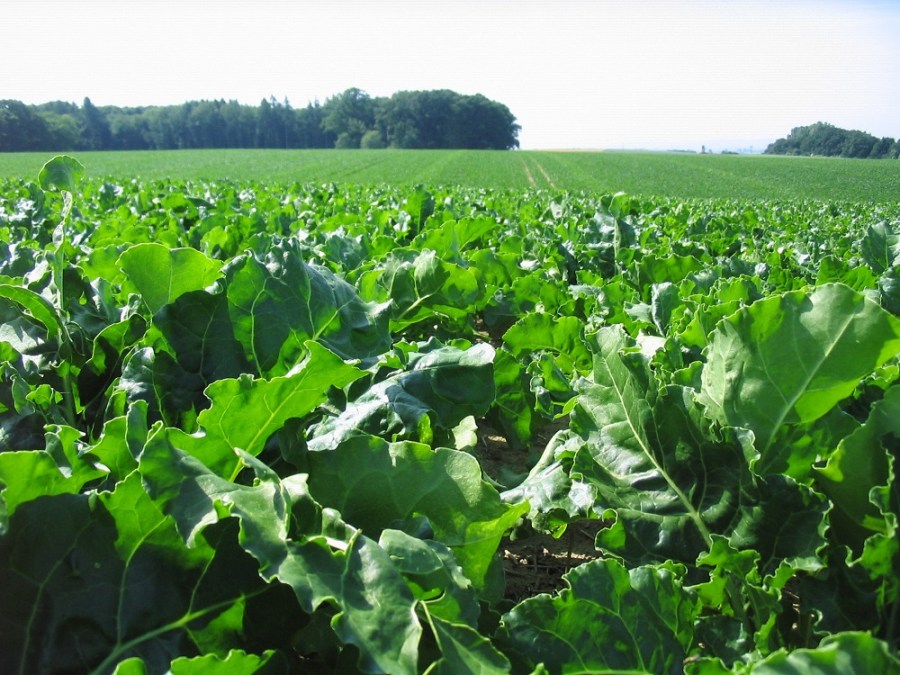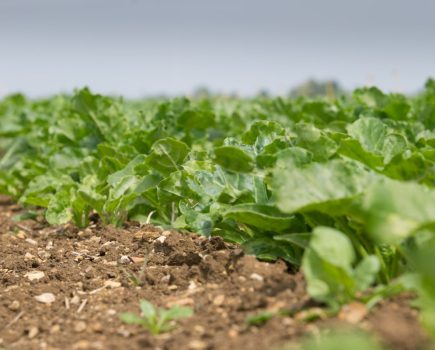Sugar beet variety traits were in the limelight at BBRO’s technical meetings last month, with a focus on how these may assist growers as the crop comes under new challenges brought on by a changing climate. CPM reports.
We had a legacy effect from the neonics in 2019.
By Lucy de la Pasture
There’s a lot of discussion about mitigating the effects of climate change but very little on how crop production may be influenced over the next few decades. Prof Steve Dorling, a meteorologist at University of East Anglia (UEA), opened the meeting by giving an insight on the changes in weather patterns.
He began by explaining the UK climate can be very variable. “Sometimes there’s not enough water and at others, there’s way too much water. This year it’s too much.”
Rainfall for the autumn (Sept-Nov) last year amounted to 170% of the 30-year average in East/North East regions, with winter rainfall still be calculated it’s likely to add up to a very wet six months. That’s in line with the most recent climate change predictions, with drier and warmer springs and hotter summers expected to follow wetter and warmer autumns and winters.
“Since 1950 the temperatures across Europe are rapidly changing, with the past decade becoming noticeably warmer (according to weather data). In the UK this translates to an increase in the average growing degree days – from 1472 in the period 1961-1990 to 1695 from 2009-2018. In 2018 this rose to 1807.”
Steve pointed out that this increase in growing degree days demonstrates the need for up-to-date data on crop production because the climate that crops are now growing in has changed from 30 years ago.
“Over the past decade April has become drier, warmer and sunnier. It’s a change of 10% compared with the 30-year period as a whole. Growing conditions are changing.”
New, more accurate climate models suggest that by 2061-2080, the winter will be warmer by 1.9-3.3⁰C and summer by 3.6-5⁰C, assuming continued high emissions. Rainfall has a wider margin, with winter being 16-42% wetter and summer 16-46% drier.
Focusing on the sugar beet drilling window, he used historic data to illustrate how the drilling window moves from season to season because of our variation in the weather from year to year.
“On Apr 1, the 20-year data shows a wide range of soil temperatures at 10cm from 2.5-12.5⁰C. That’s our UK climate and it influences the variation we see in drilling date from season to season.”
For growers to make their crops more resilient to these changes in climate, Steve said they need more reliable information to base decision-making on. Part of his work at UEA is to develop an accurate 28-day weather forecast by county, so that growers can make better informed decisions about when it’s right to start planting their beet.
Not too far into the future, the forecast weather from ‘weatherquest’ will be available in conjunction with the catchment mapping carried out by the Centre for Ecology and Hydrology, and this will provide an high-resolution map of soil conditions in the field to give growers an even bigger picture, he explained.
One of the implications of a changing climate will be on the growth of the sugar beet crop, said BBRO’s Dr Simon Bowen. He’s been conducting a review of scientific literature to establish just what the predicted changes may mean to plant growth in the UK.
“Higher spring temperatures will mean earlier drilling and faster, earlier canopy establishment. Warmer growing season temperatures and elevated carbon dioxide levels means that there’s likely to be increased biomass production and water use efficiency, with later growth extending the growing season,” he said.
On the other hand there’s likely to be more periods of drought and an increase in some pests and diseases, with a rise in ozone levels also having a negative effect on crop growth, he pointed out.
“On balance, we believe the yield-increasing effects will be in the region of 5-25%, with the yield-decreasing effects negating about 10% of this – giving an overall net gain of 5-15% in yield.”
Simon went on to say it was crucial to continue to build soil resilience, particularly by increasing soil organic matter content, and to further develop and utilise variety traits. He highlighted bolting resistance as a trait not to overlook when drilling in an early window (before mid-March).
“Drilling earlier has been considered to be one way of protecting the crop from virus yellows infection. The aim is to get the crop to 12-true leaves, when mature plant resistance kicks in. If you adopt this approach it’s key to select the right variety to avoid bolting,” he commented.
Simon highlighted the big seasonal effect on the number of bolters, with 2016 and 2019 having higher numbers than in other recent seasons. “It highlights the need for a good forecast for the period after drilling, remembering that cold temperatures can affect plants before they emerge.”
The bolter effect can be significant for yield, with just one bolter/m2 reducing yield by 11%, but also because of weed beet – with each bolter capable of producing 1500 viable seeds, he added.
One of the pests predicted to rise in a warmer climate is beet cyst nematode (BCN) and BBRO believe it’s present on a much wider scale than originally thought. BBRO’s head of science, Prof Mark Stevens explained that BCN would produce more generations in a season with an increase in temperature and growers would feel that impact much earlier in the season.
BBRO are looking at the effect of BCN-tolerant and BCN partially-resistant sugar beet varieties on the populations of the pest, so that better use can be made of varietal traits to manage the effects and multiplication of the nematodes.
In a straw poll of delegates at the Lincolnshire meeting, 42% of growers didn’t know if they had BCN in their sugar beet fields; 26% were aware they had the pest and 20% were aware and grew a BCN-tolerant variety. This seemed to indicate better use could be made of the BCN varietal trait and more soil testing to identify fields with the pest is advisable.
Varieties with good resistance to rust also offer growers a good option for high risk fields and late-harvested crops. “On the BBRO Recommended List, varietal resistance to rust varies from 2.2 to 7.9 so it’s a factor to consider when deciding which variety to put in which field and which ones to assess as a priority when deciding when to start your fungicide programme,” added Simon.
But the one pest growers were anxious to hear most about was Myzus persicae and the incidence of virus yellows. Mark highlighted that warmer winter temperatures would result in earlier migration of aphids into sugar beet crops, when the crop is most likely at a smaller growth stage than under current migration patterns.
Having just navigated the first season without neonicotinoid seed treatments in 25 years, the incidence of aphids and virus yellows in 2019 is a signpost of things to come.
“2018-2019 was a mild winter and enabled aphids to over-winter. The virus yellows forecast produced in March last year was for 22-54% of the sugar beet crop to be at risk of infection. We caught a record number of M. persicae (39,243) in the yellow water pan trapping programme, which is intended to provide an early warning of aphid migration and trigger regular field inspection of crops to look for green wingless aphids,” he explained.
“We tested 10,000 of the aphids we caught for virus yellows and 0.4% were found to be carrying it. I believe we had a legacy effect from the neonics in 2019 and the likelihood is that the further away we get from their last use, the more virus levels will increase.”
Insecticide usage for aphid control by growers corresponded fairly closely to a poll taken in the room. 16% of the crop didn’t need an insecticide; 38% received Biscaya (thiacloprid) followed by Teppeki (flonicamid); 20% received a single application of Biscaya and a 21% a single application of Teppeki. Only a small percentage, 3%, received the full-monty of two Biscaya applications and one Teppeki, according to British Sugar statistics.
“55% of fields had virus yellows last year but only 1.8% of the crop was affected. We got away with it, even though we’d caught record numbers of aphids,” commented Mark.
Putting those figures into context, he explained that in 2018 only 18% of fields had virus yellows and 0.4% the sugar beet crop was affected. “So already there’s a step-change in virus yellows. My real worry is that as we go into 2020, we’ll have more sources of virus infection which has the potential to increase the pressure on the crop about to go into the ground. Managing hygiene is going to be business critical,” he said.
The options for aphid control in 2020 currently stand at the one and only insecticide with full label approval, Teppeki. “This was the situation this time last year, but we managed to gain an emergency use approval for two applications of Biscaya. We’re working hard to gain further insecticide options through emergency applications for this season.
“We need to think and box-clever to manage virus yellows. That means thinking about how we can use predators in the field, and last year there was some interesting work where growers introduced beneficials into the sugar beet crop – which isn’t something that’s often done in an arable environment.”
Plant breeders may also have an important role to play when it comes to controlling virus yellows and Mark highlighted that it’s not an easy thing to find plant resistance genes to all three viruses that cause virus yellows in beet.
Dr Alistair Wright has been assessing virus levels and yield effects on coded varieties, with the inclusion of current RL varieties as a comparison. He says there are some promising developments from plant breeders in the pipeline which are showing varying degrees of resilience to the two main viruses in the virus yellows complex, BYV and BMYV.




